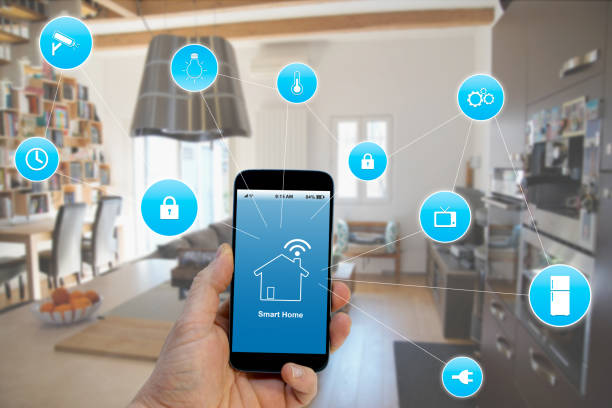In the not-too-distant future, it will be impossible for humanity to live without the assistance of smart home devices that understand your daily routines and schedules and adjust your surroundings accordingly, improving your overall quality of life. The Internet of Things (IoT) is now combining with AI (Artificial Intelligence) to revolutionize how various devices interact with one another and work together to make human lives easier. Men can now use smart home applications to do things like:
- Automatically turning on and off lights.
- Changing the room temperature according to the weather and personal preferences.
- Playing your favorite music or inhaling the aroma of freshly brewed coffee can lift your spirits.
All of this is made possible by IoT-based home automation, and everything that was once a pipe dream is now a reality. However, this is only the tip of the iceberg; IoT-based home automation has many more hidden capabilities that have yet to be discovered.
Technology for smart homes
The entire home automation industry is now being transformed by smart home technology. The days of manually controlling home devices or using the internet are long gone. IoT is now collaborating with AI, which is proving to be a lethal combination in terms of transforming how home appliances operate autonomously. Various aspects of home automation, such as utility, security, entertainment, and control systems, are constantly being updated to become smarter and faster, as well as much greener by adhering to the carbon-neutral commitment. We’ll look at some of the unique ways that IoT is shaping the future of home automation in 2022 and beyond.
Smart homes are becoming more intelligent
As long as they are connected to the internet, home appliances will not become smarter. Connected devices is a better term for the technology we now use. Over the next few years, this will change, as more devices will begin to function autonomously, using machine learning and computer vision to make decisions using deep learning.
Smart switches can currently control a wide range of home appliances, including air conditioners, smart lights, thermostats, washing machines, refrigerators, water pumps, and coffee makers, among others. Mobile apps, smart wearables, voice commands, and other methods of control are available. This is also about to change, as these can use data analysis, deep learning algorithms, and artificial intelligence to predict user preferences and adapt to user behavior for smarter operations.
Designed with the ability to self-diagnose
As we’ve seen, the use of artificial intelligence and machine learning in IoT-based smart home management is causing appliances to become increasingly self-aware in terms of autonomous function. These can also alert you when they require maintenance or repairs. This function can be found in many modern cars, industrial machinery, and other devices. Future equipment will automatically alert manufacturers and service teams to potential failures and errors so that they can be addressed quickly.
Smart devices can use computer vision by thinking ahead. For example, a home refrigerator can monitor what’s inside and predict what needs to be ordered in the coming days using machine learning techniques. These can serve as reminders for homeowners to go grocery shopping or place orders on their own. Consider getting a notification from your fridge to buy the groceries you’ll need for the coming week based on your priorities. Your vehicle’s GPS can also recommend a route based on the proximity of a store where you can get the groceries you need. This is one of the most basic use cases for AI in the IoT.
Enhanced safety
Security is currently one of the most important use cases of IoT, which is still in its early stages. IoT-enabled homes can identify their owners, frequent visitors, and friends, among other things. It can also notify you of strangers on your doorstep, as well as deliveries and other services. You can also set up video doorbells with the help of connected devices, which can collect information about visitors over the internet and notify the homeowners who is at the door. Homeowners can also remotely access the main door locks, and if a break-in attempt occurs, information can be shared with the police department immediately.
IoT-based security appears to have a brighter future. As we’ve seen, IoT will combine analytics, machine learning, and artificial intelligence to make home security more intelligent and foolproof. The biggest players in home automation, such as Google, Amazon, and others, are now investing billions of dollars in IoT-based home automation, and there are many more things in the pipeline. All of this will improve the security and comfort of IoT homeowners.
Systems for Entertainment
One of the primary concerns of modern-day homeowners is home entertainment, which is considered one of the primary and integral applications of IoT home automation. Users can stream music from any part of their home using a smart speaker, and choose different tracks for different rooms, thanks to modern home entertainment IoT applications. It’s also possible to link the music output to a smart LED, which can light up the room or dance to the beat and mood of the music, creating an aesthetic effect.
Machine learning and deep learning have the potential to revolutionize home entertainment by allowing it to operate autonomously based on the user’s moods. There is a lot of research going on in this area, and services like Amazon Alexa and Amazon Prime, among others, are making significant advances in their home entertainment automation applications.
Another major application of IoT home automation is smart healthcare. At home, self-contained systems will monitor the health of the residents and provide alerts and inputs as needed. There will also be a greater reliance on home automation robots to perform tasks such as lawn mowing and vacuuming. These robots will also be capable of performing other tasks, such as cooking for their owners.

